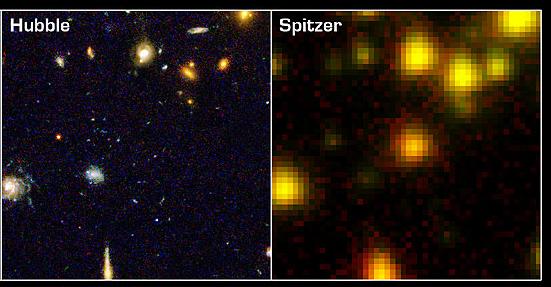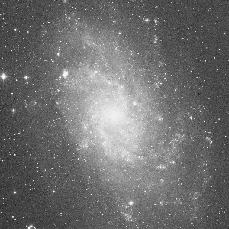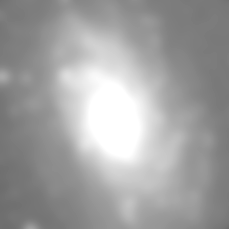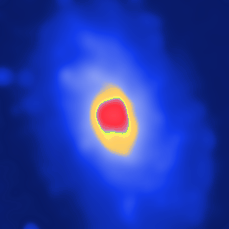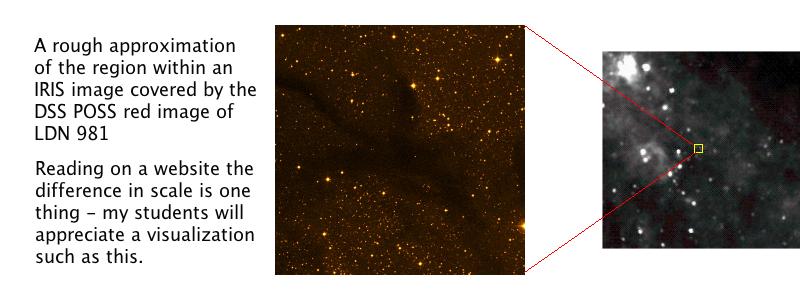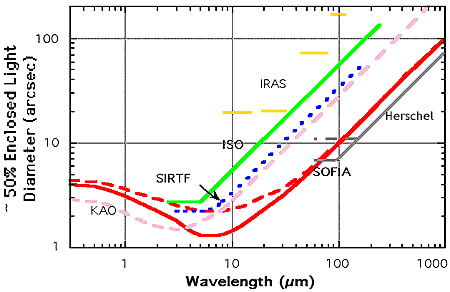Difference between revisions of "Resolution"
m |
m |
||
| Line 24: | Line 24: | ||
[[image:Crisldn981.jpg]] | [[image:Crisldn981.jpg]] | ||
| + | |||
| + | =Spitzer's resolution= | ||
| + | |||
| + | Spitzer's resolution is a strong function of wavelength. The following plot comes from the SOFIA website, and is from at least 2003 if not earlier. | ||
| + | |||
| + | [[image:sofiaspatial.gif]] | ||
| + | |||
| + | =Useful Links= | ||
[http://blogs.discovermagazine.com/badastronomy/2008/08/12/moon-hoax-why-not-use-telescopes-to-look-at-the-landers/ Article on resolution] from Bad Astronomy - this is in the context of debunking the moon hoax, but resolution issues are important for his discussion. | [http://blogs.discovermagazine.com/badastronomy/2008/08/12/moon-hoax-why-not-use-telescopes-to-look-at-the-landers/ Article on resolution] from Bad Astronomy - this is in the context of debunking the moon hoax, but resolution issues are important for his discussion. | ||
Revision as of 20:14, 22 January 2010
Contents
Introduction
One thing that even the average professional astronomer might not fully appreciate is that Spitzer's images are diffraction-limited. Every telescope in space can produce images limited only by the effects of diffraction -- this effect is stronger for longer wavelengths and smaller telescopes -- but diffraction will only be noticed if the camera on the telescope samples the telescope's output finely enough. Most of Spitzer's images of point sources show diffraction rings because of the telescope's small size (85 cm) and long observing wavelengths (3-160 um). The size of patch on the sky (pixel size) that Spitzer measures increases in size from 1.2" at 3.5 um to 15" at 160 um. In practice, what this means is that very bright sources, especially those seeen with MIPS, will appear to have rings around them - this is the first Airy ring, e.g., a result of the way the telescope responds to light of this wavelength. It's not really a ring around the object.
In the picture on the right (taken from this press release), you can see a (small) patch of sky imaged with Hubble (left) and Spitzer (right). The original point of this image was to show how phenomenally sensitive Spitzer is - there is a thing in the center of the Spitzer frame that is not seen by Hubble. There is something else you can learn from this image too. Look at the upper right of the Hubble image. See all the variations in size and shape of the galaxies there? Look at the same region in the Spitzer image. To Spitzer, they all look the same - similarly sized and shaped blobs. Spitzer's telescope is small (just 85 cm) and the wavelengths of light Spitzer uses are long (comparatively), so the resolution of Spitzer is limited.
Comparing images of multiple wavelengths
When comparing images at different wavelengths, check that the spatial resolution is comparable! This matters, particularly for mid- and far-IR observations. You will notice this if you use images of different resolutions in a 3-color composite.
Related to this issue of resolution is the size of images that you can download using any of a number of online resources. For surveys with low spatial resolution, often the default size of the image you can download is MUCH MUCH larger than the default size of an image you can download from a survey with high spatial resolution.
Spitzer's resolution
Spitzer's resolution is a strong function of wavelength. The following plot comes from the SOFIA website, and is from at least 2003 if not earlier.
Useful Links
Article on resolution from Bad Astronomy - this is in the context of debunking the moon hoax, but resolution issues are important for his discussion.
Questions to think about and things to try having to do with resolution
- What is the size of a typical HST image? How does it compare to a single Spitzer image, or a 'typical' Spitzer mosaic, or a single POSS plate, or the field of view of an optical telescope you have used, all compared with the size of the full moon? How does that compare to the size of a recent comet that visited the inner Solar System? or the size of a spiral arm of the Milky Way? You will have to go find on the web things like the field of view of these telescopes and these objects.
- Can you create a 3-color mosaic using just Spitzer data where the different resolutions of the various cameras is noticeable and important?
- Bonus question: how does the spatial resolution of all those telescopes listed above compare? (e.g., what is the smallest object you can resolve as more than a point source?)
